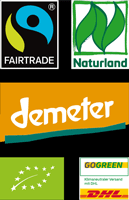- Commitment
Saving water with coffee?

Barbara Beiertz
Water is in fact not my element. I don’t like swimming. I prefer showering over taking a bath. And honestly? I rather have a coffee than water. So basically, I am quite economical when it comes to the precious commodity. At least that’s what I thought.
But did you know that the average water consumption of Germans is “only” 34 gallons per day?
Plus, an additional 1050 to 1320 gallons of so called virtual water. Meaning the amount of water required to produce various products – whether tomatoes, phones, or t-shirts. And because we are world Champions in importing goods from water-scarce regions – like Spanish tomatoes – the German water footprint does not look all that good anymore:
377,766 gallons of water per resident per day
That is just a tiny bit more than 12,410 gallons (34 gallons x 365 days)… The interesting thing about it: Almost 70% of the consumption is caused outside of Germany. And how these regions look like became quite obvious during the last summers.
One could say now: “Well, we are paying for these things. Then the countries must economize better…” And: “If I cut short on this end, that doesn’t help over there”. But that is not true. It does. You can make a huge difference. Each and every one can. You could for example ask yourself you need to buy roses from Kenia. Or wine from South Africa. Do you need strawberries in winter? And another shirt that is on sale?
In a nutshell: You can buy regional and seasonal. You can wear your clothes longer. Use items longer. You can eat less meat, because that has a double negative effect in terms of water consumption because of the feed production. And: You can support organic and Demeter cultivation. Which is what we do.
The water footprint is not evaluated in the certificates. But as our Demeter coffee farmer in Peru proves quite lively, the biodynamic cultivation improves the soil quality significantly. And not only with regard to nutrient content and the microorganisms, but also regarding the ability to store water, which is significantly better compared to the conventional cultivation.
One reason for that are the shade trees, under which our coffee grows, in small, so-called coffee gardens. There, less water evaporates. Also, the groundcover, which is not eradicated by herbicides, helps to improve the soil. It is rich in humus and has a good root penetration which improves the ability to store more water. Have a look at this short video, where you can see all of it “live and in color”.
The great thing about this extraordinary farm La Chacra D’dago is, that water is successfully conserved though recycling. It is for example used in a closed circuit to wash the coffee cherries and is then cleared in a “natural 3-tank-plant” together with the water from the fermentation process, where the pH level is neutralized. That way, it can be fed into the river again without having any negative effects.
This system works so efficiently, that coffee farmers in the region are thinking about using it for themselves and even the municipal administration in Villa Rice is considering its implementation. Not so bad for Demeter farmers who had not been taken serious for a long time, don’t you think?
We are going to tell you a lot more about this farm in the upcoming weeks and months. Peru is beautiful. La Chacra D’dago is a paradise. And the people there are far more than just “our” coffee suppliers. They are friends. Good friends.
*WHAT IS VIRTUAL WATER?
In general: The water that is consumed in all(!) steps of the manufacturing process of a product or a service.
Example: 2.2 lbs of beef require worldwide an average of 3,963 gallons of water (93% green, 4% blue, 3% grey water foot print). But there are major deviations depending on the type of farming and the composition and origin of the feed.
There are three types:
• green virtual water for precipitation and natural soil moisture.
• blue virtual water for artificial irrigation
• grey virtual water, that is affected during its usage (by fertilizers, pesticides, industrial waste) and can only be recycled to a limited extend.



